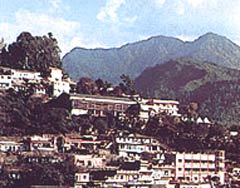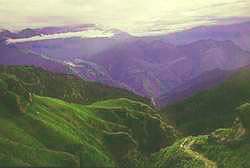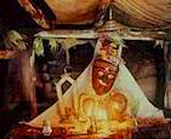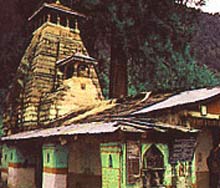| Trekking
Panch Kedar Trek: Act 2 - Rudranath |
|||||
Having taken several short rides to reach the 50 odd kms from Helong to Gopeshwar, I was exhausted from my travels, which seemed to consist of intermittent waits, a broken down bus, the day's only 'share jeep' that waited forever to fill up. The only satisfying part of the day had been my walk upto Kalpnath from Urgam village and then the 9-10 km hike to Helong. By early evening I had reached Gopeshwar and settled myself into the hotel and organised my guide-porter through one of the temple priests of Rudranath, as recommended by Prabhat Dimri, Operations Manager, GMVN at Joshimath. Without any intention of doing so, I got caught up in the local activities of the area. Rajinder Singh Negi, at whose lodge I had stayed the previous night at Urgam, along with the gram pradhan or village head of Urgam, visited me. I soon found myself seeking an appointment with the District Magistrate who invited me for a meeting with all the various petitioners who had gathered in a matter of a couple of hours, whether by chance or design. We had a good meeting with the DM, who listened with empathy and an open mind to what needs to be done to preserve the trails to the Panch Kedar, without commercialising them beyond redemption. In turn, the DM had invited the tourism officer and the local politician for a discussion and got in touch with Govt functionaries in the Forest and PWD Departments. |
More on Uttarakhand • Overview • Char Dham
Trekking
Photo Gallery
Travelogues
Adventure activities | ||||
The forest path took me back to childhood summers spent in the forests at Takdah near Darjeeling. There is something about untrodden forest paths that are familiar yet unknown. I feel at home with the sounds of the insects, the occasional ripple of streams in the distance, the filtering sunlight, the dense foliage, the cool damp untouched undergrowth, the occasional fallen tree that lies in natural abandon, the sudden clearing to a blue cloudless sky. I thoroughly enjoyed walking through the forests completely alone, meeting not one human being on these remote paths. The walk through the forests was not a few hours long - it spanned my entire childhood, that included many peopled summers of children's voices and adventure trails, and a single summer with my grandmother, infinitely long, when I spent entire days completely alone on mountain paths, amidst streams and in the depths of forests. When I came to the bugyals, meadows of beauty and summer flowering, I had already crossed the bridges of childhood, and overcome the darkness of anxiety and fear of being alone in forests with only nature and wild animals. The peeping flowers, the freshness of green grass, the clarity of high altitudes, the remoteness of the interior Himalayas had seeped into my being. At Panar, when I reached the only encampment of sorts, where shepherds graze their sheep, a lone villager was making tea and khichri in a tin shed abandoned by security forces. It was the only hot cup of refreshing tea en route to Rudranath. I wolfed down the unpalatable khichri, tasteless and steaming, before beginning the climb through stark landscapes, rugged mountains, mist and clouds, ice-sheets and thin air that leave me breathless for higher heights, starker surroundings, depths of vastness and understanding that one stumbles into in these sacred spaces.
The Himalayas revealed themselves in every mood, aspect and form. The softness of imperceptible showers cooled my limbs when the ardour of the climb left me hot and thirsty. The clouds lifted a splendid moment to reveal hidden peaks, glorious beyond belief. The sun shaded itself when the climb was barren and rarefied. Clouds covered the face of a burning sun. The rain fell in mere droplets that dried before it touched my senses. The crags and stark landscapes told familiar tales. In the dim grey mist I noticed crossing the ridge between two high mountains with stones placed in asymmetrical dedication in homage of ancestors. I walked amidst barren grey mountains, unbroken, ragged, the path of ascetics in austere meditation, without any relief. And then, the skies opened and nature revealed itself again in familiar acceptable contours of attractiveness. Contrasts of sun, sky and clouds, of rhododendrons in pink, lilac, a whisper of white. Green grass and ice-sheets interspersed. There were undulating valleys and sharp bends again, not merely boulders and jagged edges and grey remorseless skies.
I crossed several ice-sheets. At one, I saw a large figure standing hesitantly, and I spoke almost from habit, "The worst thing that will happen is that you will fall down." The reply was immediate, "That madam, is what I am afraid of. I see the effects of falls every day. I am an orthopaedic surgeon." I almost crossed the slippery ice-sheet in silence. I turned back and said, "If you fall, fall like a stone, without resistance, and you will not hurt yourself." Barely a km away, the arched symbol of a gateway and the overhanging bell told me I had reached the precincts of the temple at Rudranath. I stopped naturally at a doorway, where a young priest sat in devoted dedication meditating beside the dhuni in his room. In silence, I warmed myself at the fire. A cup of tea was placed in my hands. I talked to the pujari about the wonders of Rudranath. I saw photographs and video clips he had shot - this was his first year as the temple priest, an honorary position shared by two families in time-honoured tradition. I always enjoy meeting true worshippers where the contemporary world has not touched their moment of earnest prayer offered in worship. The trekker I had met on the way joined us. The three of us spent a comfortable evening of camaraderie. They suggested I stay another day, explore the nearby areas, visit the Kunds and see the brahmakamal that grows there. I had already committed to meeting a friend at Chopta 2 days hence.
The occasional devotee comes to Rudranath to offer ritual obeisance for his ancestors, because at the Vaitrani River here, it is believed that the dead cross to other shores when entering other worlds. This is the only temple in India where the image of Shiva is worshipped as a symbol of his face. The priest stripped the angry mask off Shiva's face to reveal a sublime, tender aspect of Shiva, unusual, serene and beautiful indeed to behold. After the Puja, we sat talking at the pujari's dhuni - it was a shared moment beyond the conversation and the form. I joined the pujari for his simple meal of roti and dal, before proceeding to the shelter of four walls and a roof where I laid out my sleeping bag on the straw. The darkness of night was more total than I have ever known. I was deeply aware of the crossing souls, though I only learnt of the tale much later. Early next morning, before dawn had broken, I met the priest, already immersed in worship. I wanted to offer symbolic thanks for his gesture of hospitality. He indicated that I should leave it somewhere, because he cannot touch anything worldly until he had completed his morning worship. He added, "I will get in touch with you, when I return to the world." I agreed, having recognised a kindred spirit I was bound to meet again.
The journey to Rudranath did not belong to the usual spaces of living that can be described easily. I stayed overnight at the remote Mandal PWD bungalow, at a distance from the village. It was a breathing space between the invisible spaces of the gods and the higher echelons of man's awareness.
Biswarup Mukherjee's Travelogue of Mandal-Rudranath-Mandal.
|
|||||
Editor: Romola Butalia (c) India Travelogue. All rights reserved. |
|||||
 At 5 the next morning, along with the guide-porter, I set about the task of organising a jeep for the 6 km ride from Gopeshwar to Sagar, from where the 22 km tough trek to Rudranath begins. It was a steady ascent before we reached dense forests, with unmarked trails. My guide figured out soon enough that I like to walk alone and thereafter we would meet every hour or so to ensure that we were on the same route. Though I may not be familiar with this trail, like anyone who is at home in the Himalayas, the homing instinct is so strong, I wear a mental compass, without even being aware of it. I always regard myself as a poor trekker because I notice neither direction, nor time, nor elevation, but I am a good villager because I walk at my own measured pace in total surrender till I reach my destination.
At 5 the next morning, along with the guide-porter, I set about the task of organising a jeep for the 6 km ride from Gopeshwar to Sagar, from where the 22 km tough trek to Rudranath begins. It was a steady ascent before we reached dense forests, with unmarked trails. My guide figured out soon enough that I like to walk alone and thereafter we would meet every hour or so to ensure that we were on the same route. Though I may not be familiar with this trail, like anyone who is at home in the Himalayas, the homing instinct is so strong, I wear a mental compass, without even being aware of it. I always regard myself as a poor trekker because I notice neither direction, nor time, nor elevation, but I am a good villager because I walk at my own measured pace in total surrender till I reach my destination.  Was it a journey of a day? Why has it taken me so many months before reliving it on paper? Is it the reluctance to tread again fresh footsteps until a snowfall has obliterated footprints? Is there enough distance now between the witness and the protagonist to shield the journey of a stripped essence, raw in feeling, as all Himalayan journeys really are. I have lived long in the Himalayas, seen them in all their moods of finery and fury. Unmoved and untouched by theatricals, the Himalayas do not impress me with their awe and grandeur as much as they overwhelm me with their familiarity and their closeness. It was undoubtedly the best trekking day of my life. Words cannot capture the essence of its reality. The sun and shadows, the clouds and rain, the meadows and the peaks, the colours of brilliance in the play of nature were of total perfection.
Was it a journey of a day? Why has it taken me so many months before reliving it on paper? Is it the reluctance to tread again fresh footsteps until a snowfall has obliterated footprints? Is there enough distance now between the witness and the protagonist to shield the journey of a stripped essence, raw in feeling, as all Himalayan journeys really are. I have lived long in the Himalayas, seen them in all their moods of finery and fury. Unmoved and untouched by theatricals, the Himalayas do not impress me with their awe and grandeur as much as they overwhelm me with their familiarity and their closeness. It was undoubtedly the best trekking day of my life. Words cannot capture the essence of its reality. The sun and shadows, the clouds and rain, the meadows and the peaks, the colours of brilliance in the play of nature were of total perfection.
 When the priest, dressed in all his ritual finery, offered prolonged obeisance at the temple, I stood outside the sanctum sanctorum, my feet paralysed by the dampness of the cave temple, and meditated in silence. The rituals observed, the temple bell rang heralding the handful of trekkers and worshippers for the evening aarti at this rare Shiva temple, surrounded by Surya Kund, Chandra Kund, Tara Kund and Manas Kund and the great peaks of Nanda Devi and Trishul, among others.
When the priest, dressed in all his ritual finery, offered prolonged obeisance at the temple, I stood outside the sanctum sanctorum, my feet paralysed by the dampness of the cave temple, and meditated in silence. The rituals observed, the temple bell rang heralding the handful of trekkers and worshippers for the evening aarti at this rare Shiva temple, surrounded by Surya Kund, Chandra Kund, Tara Kund and Manas Kund and the great peaks of Nanda Devi and Trishul, among others.  I left Rudranth in quietude. It was an incredibly long and exhausting walk to Mandal, with a brief stop for lunch beside the Anasuya temple. In the long day of clambering over rock and through thicket and brush, I was gratified by the unlikely sighting of the near-extinct monal, and a herd of musk deer that frolicked and gambolled. I stopped to converse awhile with a Himalayan sage and his disciples, who were on their way to Rudranath. The sage seemed uncannily familiar but he did not reveal his identity.
I left Rudranth in quietude. It was an incredibly long and exhausting walk to Mandal, with a brief stop for lunch beside the Anasuya temple. In the long day of clambering over rock and through thicket and brush, I was gratified by the unlikely sighting of the near-extinct monal, and a herd of musk deer that frolicked and gambolled. I stopped to converse awhile with a Himalayan sage and his disciples, who were on their way to Rudranath. The sage seemed uncannily familiar but he did not reveal his identity.